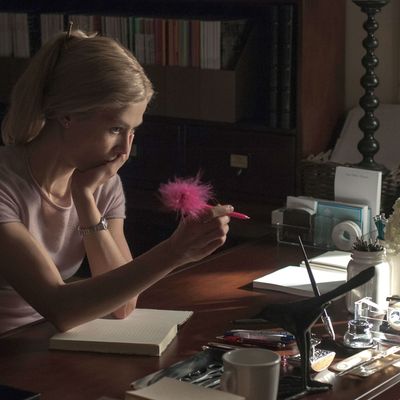
In the week after Gone Girl opened at the top of the box office with a robust $37 million, Naomi Wolf, the author of The Beauty Myth and onetime political advisor most famous for questioning Al Gore’s alpha-maleness, posted a series of, to say the least, questionable conspiratorial rantings on Facebook. The ISIS beheading videos, she suggested, were fakes; the bereft parents of the victims, featured so often on the news, were actors, and by the way, Obama was sending American troops to Africa to bring back Ebola as a pretense to institute martial law. Wolf’s theories were disarmingly similar, in form if not in content, to the kind of “false flag” narratives perpetrated by commentators like the radio host Alex Jones and, once upon a time, Glenn Beck: tales of FEMA camps, black helicopters, and shadow governments. In fact, Wolf’s suggestions follow the rough outline of several persistent and, frankly, heinous conspiracy theories floated after the massacre of school children in Newtown: The whole thing was faked, the footage was altered, and the mourning were simply actors, their grief an insidious ploy.
It seemed fitting that Wolf’s particular outburst came in the wake of the Zeitgeist tsunami that is Gone Girl. The novel has sold over 6 million copies worldwide; the film is No. 1 for two weeks running. Clearly, it’s hitting some kind of collective nerve. (As with any post-release discussion of Gone Girl, there are spoilers ahoy.) Movies, as a popular form, are especially good at barometrically detecting and exploiting our collective anxieties, whether it’s the gynophobic noir films of the post-war 1940s; or the rubber-aliens-standing-in-for-Commies B-movie romps of the Cold War; or the post–Kent State, post-Watergate paranoid fantasias of the 1970s, from The Parallax View to Marathon Man to Three Days of the Condor; or the bunny-boiling yuppie-anxiety fever dream that was Fatal Attraction in the 1980s.
Gone Girl has been dissected (and re-dissected, and re-re-dissected) as many things: an ode to misandry; a repudiation of the male gaze; an out-and-out pot-boiler in which the venomous villain just happens to be, refreshingly, a woman. But Wolf’s rant suggests there’s another modern anxiety that Gone Girl is cannily tapping in to: the post-9/11 suspicion that our entire understanding of what constitutes a conspiracy has changed.
After the Kennedy assassination, every conspiracy was a cover-up. There was the official story, strung together from sparse and disputed “facts,” then there was everything else, not yet known, but waiting to be uncovered. Who exactly was on the grassy knoll? How many shooters were there? Who were the three tramps? The central idea of a cover-up is that there’s a world of damning information, if only you can find it, buried in some dusty government archive somewhere, forever sealed away. (This love affair with the unknown unknowns surrounding JFK was expertly captured, of course, by that maestro of paranoia, Don DeLillo, in his novel Libra.) Even the notion that the moon landing is a hoax, which relies on the idea of faked footage, is essentially a conspiracy predicated on a dearth of evidence: We have only one account, so why should we trust it? And all the evidence to refute that account? Covered up by NASA. When it comes to a cover-up, the articles of faith are: The witnesses have been silenced. The relevant footage was destroyed. The documents have been buried. Yet somewhere out there is a smoking gun.
In the modern era — in which every civilian carries a video camera in his pocket and has instant access to a 24/7 global publishing platform — the idea of cover-ups no longer makes any sense. There are secrets, sure — witness the NSA — but, if anything, we’re awash in way too much evidence. If the Kennedy assassination happened today, we wouldn’t be rewatching every frame of the Zapruder film; we’d be sifting through 10,000 camera-phone videos taken from every angle and algorithmically sorting through tweets, sent live, in real time, from the scene. Think of the days following the Boston Marathon: The problem wasn’t too little proof, but too much, and a million nameless Redditors (and the New York Post) cluelessly Wiki-sorting through the endless amounts of evidentiary data. 9/11 was likely the most documented mass-tragedy in history. Thus we have the post-9/11 version of the conspiracy nut: the so-called “truther,” to whom every bit of the copious evidence must be questioned, repudiated, and disproved. As time marches on and new technology allows us to, say, see the American flags left by astronauts on the moon, the moon-landing hoax morphs from a cover-up (they’re hiding the evidence!) to a truther-style conspiracy (they’re faking the evidence!). For a truther, the goal is no longer to find the smoking gun, but to figure out which of a dozen readily available smoking guns is the one that fired the killing shot.
This is why Wolf’s rantings felt so alarming, yet so familiar: It’s a conspiracy theory precisely tailored to the modern surveillance age. Sure, there’s actual video footage of the atrocity being committed, but guess what? The footage is fake. And the news reports detailing the crimes? Bogus — the reporters are in on it, too. And all those real people, filmed from a dozen angles, who were clearly left emotionally ravaged? Actors, every single one of them. (Drawn, apparently, from some inexhaustible pool of expert and unrecognizable thespians who can convincingly play grieving relatives and be trusted somehow not to post about it minutes later on Facebook.) The essential job of the modern conspiracy nut — the truther — is not to uncover evidence, but to explain exactly why the overabundance of evidence is untrustworthy and wrong.
Which makes Gone Girl the ultimate truther fable. At first glance, it’s striking that, in Gone Girl, there’s very little use of modern technology. The plot hinges on — of all the anachronistic relics! — a hand-written diary, not a left-behind blog or vlog or damning Pinterest page. And aside from the occasional glance at a laptop or passing mention of hovering bloggers, Gone Girl plays out in a surprisingly analog world: The swirling news cameras and buzzardlike cable anchors could all have existed in the same roles 20 years ago.
But Gone Girl does expertly capture the sense of this post-cover-up conspiracy: in other words, death by too much evidence. Nick, the patsy in our story, is nearly buried alive under an avalanche of so-called proof. And Amy proves to be an expert in modern technological treachery — the film’s most haunting image may be her silent, primal scream as she coldly fakes the damning surveillance video footage at Desi’s cabin that will confirm her story of abduction and rape. Who, then, can possibly contradict her? After all, the camera doesn’t lie.
And yet, if you’re inclined toward the brand of modern paranoia practiced by Wolf or Jones or, let’s face it, the internet, then the camera does lie all the time. Nick is not the victim of a cover-up, but by the end, he’s definitely an Amy truther. As are we, the audience. Nick’s tale confirms what Wolf and her truther ilk suspect. All the proof is untrustworthy. All the footage is faked. All the victims are actors. And the defining, vaguely nihilistic belief of the modern conspiracy theorist is no longer that the truth is out there. It’s that nothing out there is the truth.




